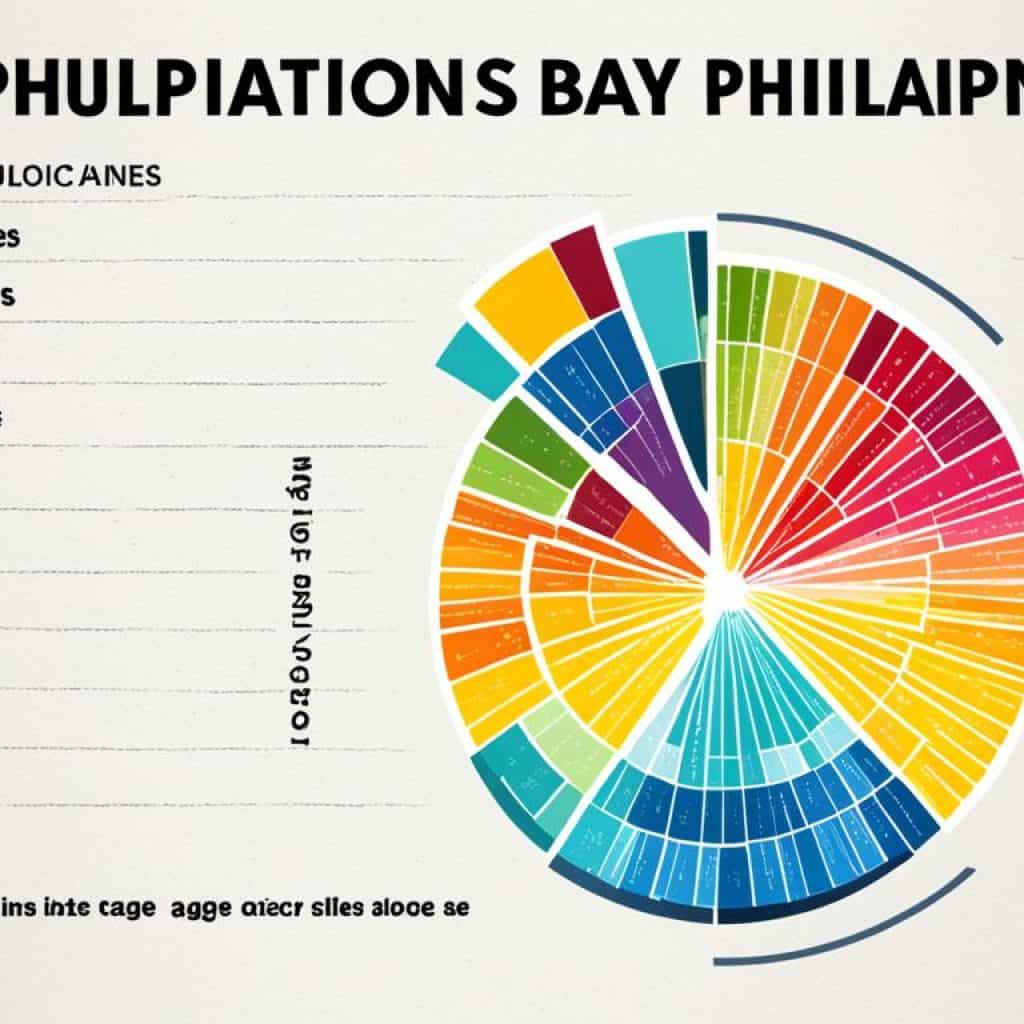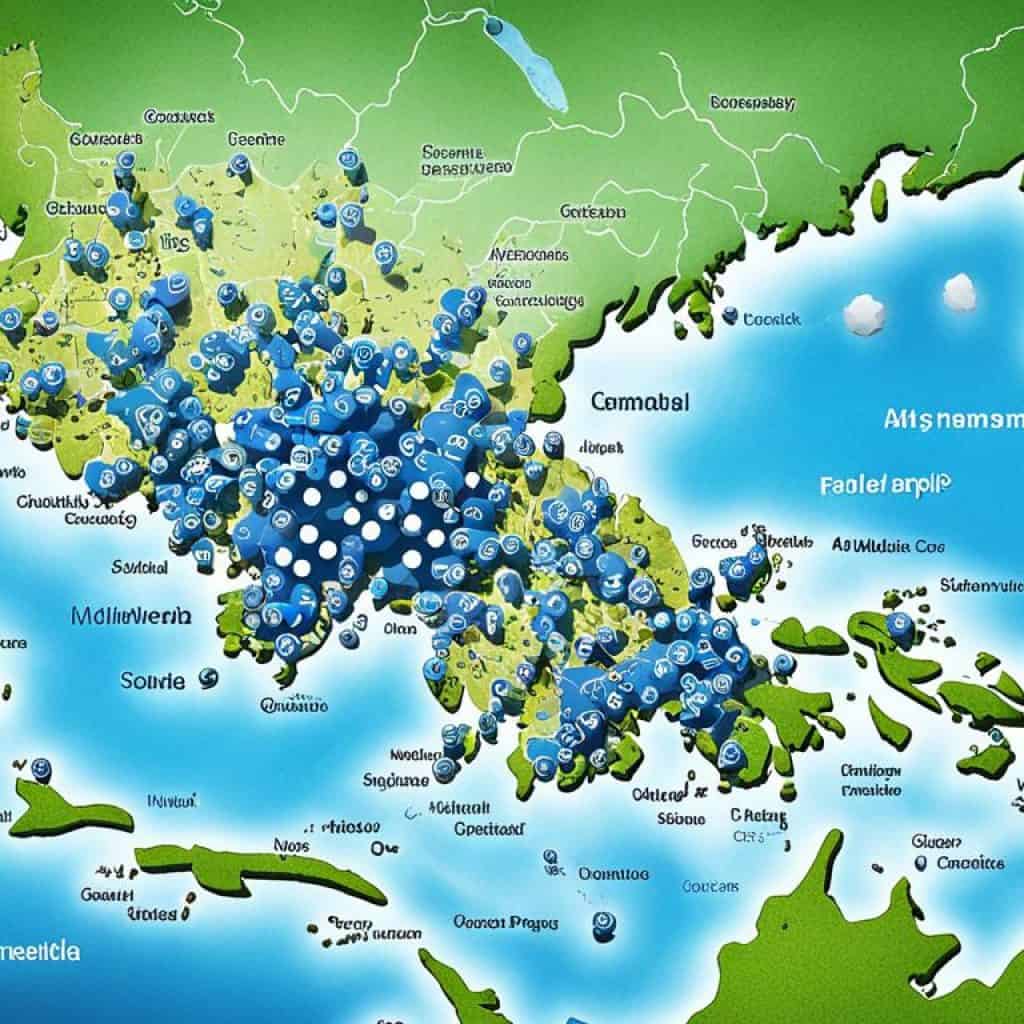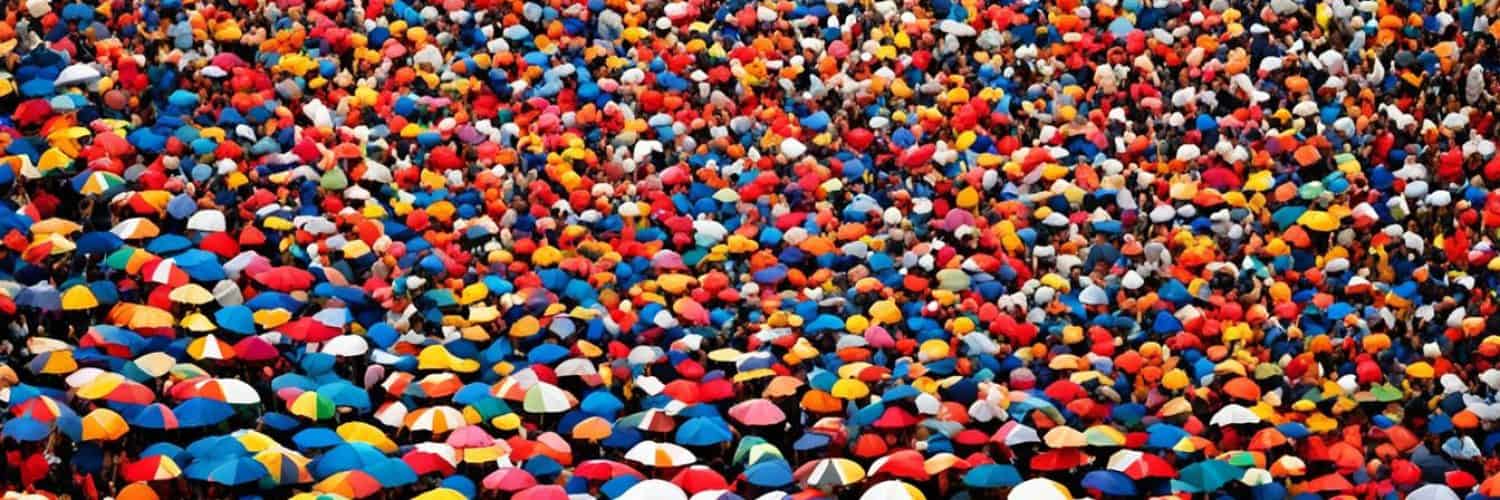Have you ever wondered about the population of the Philippines? How does it compare to other countries? What are the demographics and growth trends? Brace yourself for some fascinating facts and figures that will take you on a journey into the heart of the Philippines’ population landscape.
The Philippines, a vibrant and diverse country in Southeast Asia, is home to a population of 118,482,175 as of February 24, 2024. But what does that number really mean? Let’s dive deeper.
Key Takeaways:
- The population of the Philippines is 118,482,175 as of February 24, 2024.
- The country ranks 13th in the list of countries by population.
- The Philippines has a population density of 394 people per square kilometer.
- The median age in the Philippines is 25.0 years.
- Stay tuned to explore more about the population growth trends, urbanization, age distribution, internet usage, and the future projections for the Philippines.
Population Growth Trends in the Philippines
The population of the Philippines has experienced significant growth over the years, reflecting the nation’s dynamic demographics and evolving societal landscape. This section will explore the population growth trends in the Philippines, shedding light on the country’s remarkable demographic journey.
From 1950 to 2023, the population of the Philippines surged from 28.5 million to an estimated 117.3 million. This remarkable growth can be attributed to various factors, including improved healthcare, advances in sanitation, and increased accessibility to education. These factors have positively impacted the overall well-being of the populace, leading to a decline in mortality rates and an increase in life expectancy.
It is noteworthy to mention that the annual population growth rate in the Philippines has sustained an upward trajectory. In recent years, this growth rate has averaged around 2%, indicating a steady increase in the population size. As of now, the current growth rate stands at 1.51%, highlighting the ongoing expansion and dynamism of the Philippine population.
Key Population Growth Trends:
- The population of the Philippines has grown from 28.5 million in 1950 to 117.3 million in 2023.
- The annual population growth rate has averaged around 2% in recent years.
- The current growth rate stands at 1.51%, showcasing a sustained upward trajectory.
This growth in population has far-reaching implications for various aspects of society, including infrastructure development, education, healthcare, and urban planning. As the population continues to expand, policymakers need to be proactive and implement sustainable strategies that address the emerging challenges and opportunities associated with an evolving demographic landscape.
Urbanization in the Philippines
The Philippines has experienced rapid urbanization in recent years, with an increasing number of people moving to urban areas in search of better opportunities and amenities. Currently, approximately 47.1% of the population resides in urban areas, contributing to the country’s urbanization trend.
Urbanization has led to the development of bustling urban centers and a significant rise in the urban population. The largest cities in the Philippines by population include Quezon City, Manila, and Caloocan City. These densely populated cities serve as hubs for economic activities, education, healthcare, and cultural exchanges.
“Urbanization is shaping the landscape of the Philippines, transforming cities into vibrant, dynamic spaces where diverse communities thrive.”
The urbanization rate in the Philippines is a reflection of its growing economy and increasing opportunities in urban areas. As more infrastructure projects are implemented and businesses expand, urban centers become more attractive to individuals seeking employment and a better quality of life.
Furthermore, urbanization has resulted in higher population densities in urban areas, with buildings towering over the landscape and providing homes to the growing urban population. The concentration of people in these areas has also led to the development of efficient transportation systems, social services, and entertainment options to cater to the needs and preferences of urban residents.
| City | Population |
|---|---|
| Quezon City | 2,960,048 |
| Manila | 1,780,148 |
| Caloocan City | 1,583,978 |
The table showcases the population of the largest cities in the Philippines, highlighting the significant number of people living in urban areas. These cities serve as key drivers of economic growth and cultural exchange, attracting both local and international investments.
As urbanization trends continue to shape the Philippines, it is crucial to manage the challenges associated with rapid urban growth, such as traffic congestion, affordable housing, and environmental sustainability. Government initiatives and urban planning strategies that promote inclusivity, accessibility, and sustainable development are essential for creating livable and resilient urban spaces.
Population Distribution by Age in the Philippines
The population of the Philippines is characterized by a relatively young demographic profile, with 52% of the total population below 24 years old. This indicates a predominantly youthful population that presents both opportunities and challenges for the country’s development.
The median age in the Philippines is 25.0 years, highlighting the youthfulness of the population. This means that half of the population is below this age, while the other half is above it. With a median age of 25.0 years, the Philippines has a significant working-age population that can contribute to the country’s economic growth and productivity.
| Age Group | Percentage of Population |
|---|---|
| 0-14 years | 32% |
| 15-24 years | 20% |
| 25-54 years | 38% |
| 55+ years | 10% |
The age distribution of the Philippine population shows a significant proportion in the working-age range of 25-54 years. This implies a potential labor force that can drive economic productivity and contribute to the overall development of the country.
However, the youth population also poses challenges in terms of providing adequate education, healthcare, and employment opportunities. It is crucial for the government and other stakeholders to invest in programs and policies that promote the well-being and development of the youth.
Overall, the age demographics of the Philippines reflect a youthful population with a median age of 25.0 years. This presents a demographic dividend that can be harnessed for economic growth and social progress. By addressing the specific needs and aspirations of the youth, the Philippines can leverage this demographic advantage to build a prosperous and inclusive future.

Internet Usage in the Philippines
The Internet has become an integral part of daily life for many in the Philippines, with a substantial increase in internet usage in recent years. As of the beginning of 2024, there were 86.98 million internet users in the country, representing a remarkable 73.6% of the total population. This signifies a significant level of digital adoption and highlights the growing importance of the online world in the lives of Filipinos.
The rapid rise in internet penetration has played a crucial role in transforming various sectors, including education, communication, and commerce. With more people gaining access to the internet, digital platforms and online services have become more accessible to a broader audience.
Internet penetration rate:
In 2024, internet penetration in the Philippines reached an impressive 73.6%. This indicates a significant number of individuals who have embraced digital technology and are actively using the internet as an essential tool for their daily activities.
The increasing internet penetration rate has paved the way for improved connectivity and enhanced digital literacy. It has empowered the population to explore a wealth of information, connect with others, and utilize online platforms for various purposes, ranging from educational resources and entertainment to online shopping and financial transactions.
Digital adoption in the Philippines:
The Philippines has experienced a substantial increase in digital adoption, driven by the rising internet usage and the availability of online services. As more individuals have gained access to the internet, they have embraced the benefits and convenience offered by digital platforms, contributing to the overall growth of the digital economy in the country.
The widespread adoption of digital technology has opened up new opportunities for businesses, entrepreneurs, and individuals alike. It has created an ecosystem that supports innovation, e-commerce, and digital entrepreneurship, fostering economic growth and development in the Philippines.
Enhancing Connectivity and Bridging the Digital Divide
Efforts are being made to enhance connectivity in rural areas and remote communities, aiming to bridge the digital divide and ensure equal access to online opportunities. Initiatives such as the National Broadband Plan and the Free Wi-Fi for All Program have been implemented to provide affordable internet access across the country, further promoting digital inclusion and equitable participation in the digital age.
Internet Usage in Numbers
In 2024, there were 86.98 million internet users in the Philippines, accounting for 73.6% of the total population.
| Year | Number of Internet Users (Millions) | Internet Penetration Rate (%) |
|---|---|---|
| 2024 | 86.98 | 73.6% |
The table above provides a snapshot of the internet usage statistics in the Philippines in 2024. It showcases the significant number of internet users in the country and the high level of internet penetration, reflecting the widespread adoption of digital technology.
The growth in internet usage and digital adoption in the Philippines is set to continue, fueling further advancements in various sectors and contributing to the country’s overall development in the digital age. As more individuals embrace the opportunities offered by the internet, the Philippines is poised to witness even greater digital transformation and innovation in the years to come.
Social Media Statistics in the Philippines
Social media usage in the Philippines has soared in recent years, becoming an integral part of daily life for millions of Filipinos. As of January 2024, there were 86.75 million active social media users in the country, accounting for an impressive 73.4% of the total population.
One of the most popular social media platforms in the Philippines is Facebook, with a staggering 86.75 million users. The platform has become a virtual community for Filipinos, connecting friends, families, and businesses across the nation.
With such a high social media penetration rate, it is clear that Filipinos have embraced the power of digital connectivity and online engagement. Social media has revolutionized the way people communicate, share information, and express themselves.
Social Media Penetration Rate
The social media penetration rate in the Philippines is a testament to the country’s tech-savvy population. With a penetration rate of 73.4%, it is evident that social media platforms have successfully integrated into the fabric of Filipino society.
Facebook Users in the Philippines
With 86.75 million Facebook users, the platform has a massive reach in the Philippines. Facebook’s popularity can be attributed to its user-friendly interface, diverse features, and the ability to connect with a wide range of people and interests.
People use Facebook for various purposes, including staying updated on news and events, sharing photos and memories, promoting businesses, and engaging in online communities. The platform has become a powerful tool for social interaction, entertainment, and information dissemination.
Social media has transformed the way Filipinos connect and interact with each other. It has bridged distances, fostered new relationships, and provided a platform for creativity and self-expression.
| Social Media Platform | Number of Users (in millions) |
|---|---|
| 86.75 | |
| 17.28 | |
| 22.54 | |
| 6.91 |
Mobile Connectivity in the Philippines
Mobile connectivity in the Philippines has reached widespread adoption, connecting people across the archipelago. With a high mobile penetration rate, cellular mobile connections have become an integral part of daily life for the majority of the population.
Cellular Mobile Connections in the Philippines
The Philippines boasts an impressive total of 117.4 million active cellular mobile connections as of early 2024, which is equivalent to an astounding 99.3% of the country’s total population. This exceptional mobile connectivity has bridged the digital divide, allowing Filipinos to stay connected, informed, and engaged.
Mobile Internet Connection Speeds
Improvements in mobile internet connection speeds have further enhanced the digital experience for users in the Philippines. The median mobile internet speed stands at an impressive 27.75 Mbps, enabling seamless browsing, online communication, and access to digital services.
With such widespread mobile connectivity and fast internet speeds, the Philippines is embracing the digital age, empowering individuals and businesses to thrive in the digital realm.
| Statistic | Value |
|---|---|
| Total Cellular Mobile Connections | 117.4 million |
| Mobile Penetration Rate | 99.3% |
| Median Mobile Internet Speed | 27.75 Mbps |
Mobile connectivity in the Philippines has revolutionized the way people communicate, access information, and participate in the digital economy. The widespread availability of cellular mobile connections and high internet speeds lay the foundation for a digitally connected nation, fostering innovation, economic growth, and societal development.

Population Density and Urbanization
As urbanization continues to shape the landscape of the Philippines, population density becomes an increasingly significant factor. With a population density of 394 people per square kilometer, the country experiences a diverse range of living environments—from tightly packed urban areas to more spacious rural regions.
Urban centers in the Philippines exhibit higher population densities compared to rural areas, reflecting the concentration of people in cities. This trend is a result of urbanization, which has seen an urbanization rate of 48.5%—meaning almost half of the population resides in bustling urban centers.
The rural-urban divide becomes apparent when analyzing population density. While urban areas experience higher population density due to concentrated city populations, rural areas boast more expansive spaces where people are spread out, resulting in lower population density.
It’s important to note that population density and urbanization have implications for various aspects of society, including infrastructure development, resource allocation, and social services provision.
| Population Density Comparison | Urban Areas | Rural Areas |
|---|---|---|
| Population Density | High | Low |
| Living Environments | Limited Space | Spacious |
| Urbanization Rate | 48.5% | N/A |
Historical Population Trends in the Philippines
The population of the Philippines has experienced remarkable growth over the years, reflecting the country’s dynamic demographics. From 1950 to 2023, the population has seen a significant increase, rising from 28.5 million to 117.3 million. This surge in population can be attributed to various factors, including improved healthcare, advancements in technology, and favorable economic conditions.
One of the key metrics to understand population trends is the annual population growth rate. This rate indicates the percentage change in population over a specific period. In recent years, the Philippines has witnessed a varying population growth rate. As of the most recent data, the growth rate stands at 1.51%.
The steady increase in population is a testament to the resilience and vitality of the Filipino people. It showcases their ability to adapt to changing circumstances and achieve progress despite challenges. However, it also presents unique opportunities and challenges for the country in terms of infrastructure development, social services, and sustainable urbanization.
“The population of the Philippines has seen remarkable growth, reflecting the dynamic nature of the country’s demographics.”
Population Growth Rate Comparison
| Year | Population | Population Growth Rate |
|---|---|---|
| 1950 | 28.5 million | N/A |
| 1970 | 36.2 million | 2.19% |
| 1990 | 60.7 million | 2.41% |
| 2010 | 92.3 million | 1.73% |
| 2019 | 109.6 million | 1.51% |
This table provides a snapshot of the historical population trends in the Philippines, highlighting the growth rate at different points in time. It is important to note that the growth rate has gradually declined over the years, reflecting the country’s transition to a more stable and mature population structure.
The historical population trends in the Philippines underscore the significance of understanding demographic changes and their implications for social, economic, and environmental factors. By gaining insights into population patterns, policymakers and stakeholders can make informed decisions and implement strategies to ensure sustainable development and a high quality of life for all.
Demographic Dividend in the Philippines
The Philippines possesses a valuable demographic dividend, fueled by its substantial youth population. With 52% of the total population below 24 years old, the country has a tremendous opportunity for economic growth and development. This demographic advantage offers immense potential for advancing key sectors, driving innovation, and stimulating productivity.
The youth population in the Philippines represents a dynamic and energetic force that can significantly contribute to the country’s prosperity. By nurturing and harnessing their talents, skills, and ambitions, the nation can unlock its economic growth potential and position itself as a global player.
To fully realize the benefits of the demographic dividend, it is essential to prioritize investment in the education and well-being of young people. By providing quality education, vocational training, and relevant skills development, the Philippines can equip its youth with the tools they need to succeed in a rapidly evolving global economy.
Additionally, ensuring access to healthcare, social services, and employment opportunities is vital for creating an enabling environment that empowers the youth population. By addressing the specific challenges and aspirations of young Filipinos, the nation can foster an inclusive and equitable society, where everyone can thrive and contribute to its prosperous future.
“Investing in the education and well-being of our youth is an investment in the future of the Philippines. By empowering them with the necessary skills and opportunities, we can unleash their immense potential and drive sustainable economic growth.”
Economic Growth Potential
The demographic dividend in the Philippines sets the stage for accelerated economic progress. As the youth population enters the workforce, they can significantly contribute to various sectors, including technology, manufacturing, entrepreneurship, and services. Their creativity, adaptability, and digital savviness can fuel innovation and enhance the country’s competitiveness in the global marketplace.
Moreover, the youth population represents a substantial consumer market, driving domestic demand and stimulating economic activity. With their aspirations and purchasing power, young Filipinos contribute to the growth of industries, such as retail, e-commerce, entertainment, and tourism.
It is crucial for policymakers, businesses, and society as a whole to recognize and tap into the economic potential of the Philippines’ demographic dividend. By aligning policies, fostering entrepreneurship, and providing support for youth-led initiatives, the country can unleash a wave of sustainable economic growth and development.

Investing in the education, well-being, and empowerment of the youth population is not merely a short-term strategy but a long-term commitment to the future stability and prosperity of the Philippines. By capitalizing on the demographic dividend, the country can pave the way for inclusive growth, social progress, and a brighter future for all.
Largest Cities in the Philippines by Population
The Philippines is home to several thriving cities that contribute significantly to its urbanization and population growth. Among these cities, three stand out as the largest in terms of population:
- Quezon City
- Manila
- Caloocan City
These bustling metropolises are not only key economic and cultural hubs but also centers of diverse demographics, reflecting the rich tapestry of Filipino society. Let’s take a closer look at these major cities:
Quezon City
Quezon City, located in Metro Manila, is not only the largest city in the Philippines but also one of the most populous in Southeast Asia. With a population of over 3 million people, it offers a vibrant urban lifestyle with various residential, commercial, and educational opportunities. Quezon City is known for its beautiful parks, lively entertainment districts, and a thriving culinary scene.
Manila
Manila, the capital city of the Philippines, is a bustling metropolis that is rich in history, culture, and commerce. It is a melting pot of different cultures and offers a unique blend of the old and the new. With a population of over 1.78 million people, Manila is a dynamic city that boasts iconic landmarks, stunning architecture, and a vibrant nightlife. It is also home to several prestigious universities and institutions.
Caloocan City
Located in the northern part of Metro Manila, Caloocan City is another major city in the Philippines with a population of over 1.58 million people. It is known for its industrial and commercial districts, as well as its vibrant local marketplaces. Caloocan City offers a mix of urban conveniences and suburban charm, making it an appealing place to live and work.
These largest cities not only reflect the rapid urbanization in the Philippines but also showcase the diverse demographics and cultural landscape of the country. With their continuous growth and development, these cities play a vital role in shaping the future of the Philippines.
Future Population Projections for the Philippines
The population of the Philippines is projected to continue growing in the coming years, reflecting the ongoing demographic changes in the country. Population projections indicate that by 2025, the population is estimated to reach 120.9 million and is expected to further increase to 129.5 million by 2030. These forecasts indicate the need for sustainable development strategies to accommodate the growing population and address the associated challenges.
Ensuring adequate infrastructure, healthcare services, education, and employment opportunities will be crucial to support the future population growth. As the population continues to expand, it becomes imperative to strike a balance between urbanization and rural development, promoting inclusive growth and improving the quality of life for all Filipinos.
An Increasing Population: Opportunities and Challenges
The projected increase in the population of the Philippines presents both opportunities and challenges for the country. On one hand, a larger population can potentially contribute to economic growth as it increases the available labor force and consumer base. It can fuel innovation, entrepreneurship, and productivity, driving development in various sectors.
On the other hand, rapid population growth poses challenges in terms of ensuring sustainable resource management, equitable distribution of opportunities, and social services. It requires efficient urban planning, infrastructure development, and environmental sustainability measures to address the needs of a larger population while preserving the country’s natural resources.
“The future population projections for the Philippines signify the importance of adopting forward-thinking policies and investment in key sectors, such as education, healthcare, and infrastructure. It is crucial to nurture human capital, create job opportunities, and build resilient communities to cater to the evolving needs of a growing population.”
Planning for the Future
To effectively address the challenges posed by the future population growth, the government and stakeholders need to prioritize long-term planning and strategic initiatives. This includes investing in quality education and skills development programs to equip the younger generation with the knowledge and capabilities required for the evolving job market.
Furthermore, sustainable urban development that focuses on creating livable cities, efficient transportation systems, and affordable housing options is crucial. Balancing economic growth with social and environmental considerations will contribute to a more equitable and sustainable future for all Filipinos.
In conclusion, the future population projections for the Philippines indicate the need for proactive measures and investments to ensure sustainable development and address the evolving needs of the growing population. By harnessing the potential of a larger workforce and promoting inclusive growth, the Philippines can pave the way for a prosperous future.
Conclusion
The Philippines is experiencing a steady increase in population, fueled by a significant youth population and a growing urbanization rate. With a current population of 118,482,175, the country’s demographics present both opportunities and challenges for future development.
One key trend that cannot be ignored is the rapid growth of internet and social media usage in the Philippines. With 73.6% of the population being internet users and 73.4% active on social media, the digital landscape plays a crucial role in shaping social interactions and economic opportunities.
As the population continues to grow, it is crucial for the government and stakeholders to invest in education, infrastructure, and policies that support sustainable development. By harnessing the potential of the country’s youth population and prioritizing their needs and aspirations, the Philippines can pave the way for economic growth and social progress.
In conclusion, the Philippines’ population trends highlight the importance of understanding and addressing the evolving needs of its people. By leveraging the power of technology and investing in the well-being of its citizens, the country can navigate the challenges of rapid urbanization and enhance its position on the global stage.


















Add comment